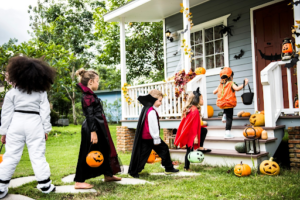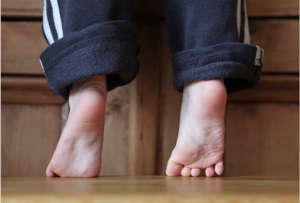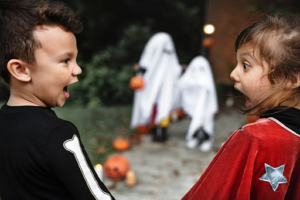Coloring a superhero coloring page, making a chalk racetrack on the driveway, or having a white board drawing competition can all be ways for your child to practice their grasp. As your child grows, the grasp they use on their writing utensil will change and can be a sign of their evolving fine motor skills. By the approximate ages listed, your child should be demonstrating these types of grasp on their writing utensil.
Category Archives: PlayWorks Blog 2022
Righty Tighty, Lefty Mighty

What is Hand Dominance?
Children should be able to use both hands in play. However, as tasks become increasingly complex, almost all children develop one hand that they use automatically to act on other objects. Hand dominance is not a preference, but a developmental process that allows the brain to advance their skills.
Your Holiday Gift Guide: From a Developmental Therapist

Collection of Christmas present boxes on a light blue background
This time of year, the same question seems to be on everyone’s mind… “What should I get the child(ren) in my life this holiday season?” Here is a guide of my favorite gifts for the children in your lives that are both fun and encourage development!
From Birth to Babble: Prelinguistic Skills to Master Before Words Emerge

You have been told to expect your child to use “one word by one year.” Great! Does this happen magically? Are there skills you should be looking for? What strategies can you implement throughout your child’s first year to facilitate their language development? We often expect that children will just “catch on” and begin speaking. For some children, this strategy works; but for many children, they need more support. Sometimes this means seeking a full speech and language evaluation; but other times, you as caregivers can implement simple strategies to help your child gain new skills.
Tips for a Sensory-Friendly Halloween

Halloween is right around the corner and while it is a highly anticipated event for many children, it can be a challenging time for those with sensory processing differences. With the wide array of sounds, sights and textures, Halloween is a sensory-rich holiday that can be overwhelming. But, with a bit of planning and consideration of each child’s unique strengths and needs, families can enjoy the festivities while navigating the many sensory experiences that Halloween brings!
Let’s Carve Out Some Fun with These Pumpkin Activities!

It’s that time of year where everywhere you look you see pumpkins! Not only do they get in the fall spirit but did you know that there are several activities you can do with a pumpkin that can help nurture your child’s development! Below are four ways that you and your child can have endless fun with just a pumpkin.
Visual Perceptual Skills
Your child’s Visual perceptual skills are an important set of skills that help them understand the world around them. So, what are visual perceptual skills? Visual perceptual skills are the ability to visually take in information and interpret that information to give it a meaning. There are seven different skills that make up visual perceptual skills. They are the the following:
Visual discrimination
Determining differences/ similarities between
objects such as size, shape, color, etc.
Visual sequential memory
The ability to recall visual sequences/
patterns
Form constancy
Identifying that an object is the same object regardless of its orientation, size, color, etc.
Visual closure
Identifying an object or person even if you can’t see the entire picture.
Visual memory
The ability to recognize visual traits of an object.
Visual spatial relations
Determining the relationships between the objects in your environment.
Visual figure ground
The ability to locate an object in a
visually busy environment.
Questions or concerns?
If you have questions or concerns about your child’s visual perceptual skills, please contact us at info@playworkschicago.com or 773-332-9439.
Urooba Khaleelullah, MOT, OTR/L
Occupational Therapist
Let’s Stop Tip-Toeing Around Toe Walking!

What is toe walking?
Toe walking can be described as walking on the toes or the balls of our feet without heel contact on the ground. It commonly can be described as your child always on their “tiptoes”. Some children with diagnoses such as cerebral palsy, muscular dystrophy, or autism may be seen walking on their toes. If a child is toe walking for an unknown cause, it can be described as idiopathic toe walking. Idiopathic toe walking is characterized by toe walking that is not occurring because of an underlying anatomical or neuromuscular cause. Factors that may play into idiopathic toe walking include;
Taking the Fright out of Halloween: How To Support Your Child This Spooky Season

Spooky season is among us. For some children, this time of the year brings warm cozy feelings, excitement about costumes and candy, and eagerness about decorating your house full of ghouls and ghosts. For others, this season may bring up fear and anxiety about the festive yet scary decorations they see around the neighborhood. If your child has been expressing more anxiety surrounding the topic of Halloween, you can create a plan to help them feel more in control and calm when it comes to seeing these unexpected decorations. Below are some tips and tricks (unfortunately not treats!) to use while making a “Halloween Plan” or “Scary Decoration Plan.”
Jump into fall with gross motor activities for all!

The weather is getting colder and the leaves are starting to change colors which means it’s fall here in Chicago! These activities are perfect for outdoor play, as well as indoor play that will help promote gross motor development for your child’s balance, strength, coordination, and motor planning skills. These activities will have your child FALLing in love with all things FALL!
What are gross motor activities and why are they important?
Gross motor activities are important for your child’s development and mobility which include crawling, walking, jumping, running, stairs, throwing, and kicking. These skills are seen throughout the development of your child as they gain more strength and mobility! Gross motor development is essential to your child’s physical well-being as well as their social and emotional growth. Creating activities that promote strengthening, balance, coordination, and motor planning are ways you can help your child meet these developmental milestones in your own home or in the community!
Check out some of these gross motor activities that your child can enjoy this fall!
